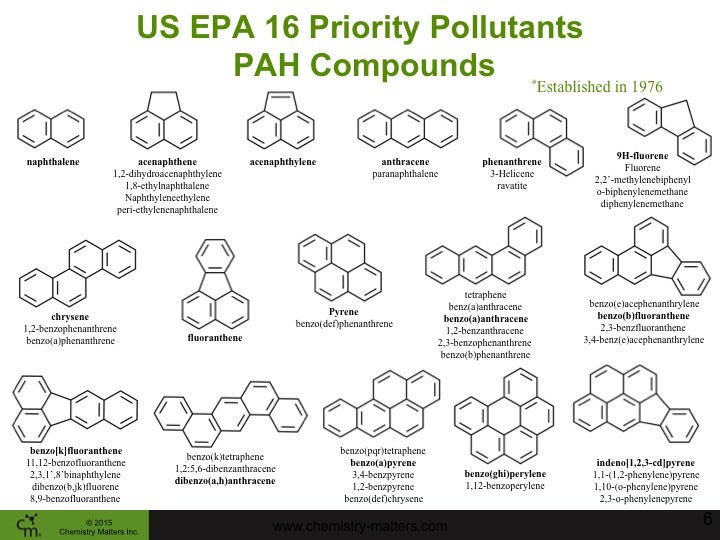I am deep into preparing materials to teach for a 2 day seminar on polyaromatic hydrocarbons (PAHs) that is coming up in November. I am gathering the information for the seminar, scouring the latest literature to find good support material. It is a very big task to get done to have something of real value for the participants. Two days seems like a long time but to cram everything we know about PAHs into that amount of time, it is not near enough. I think a entire university course could be taught on PAHs (maybe more). But, in these two days I cannot possibly cover it all.
"You cannot do it all" used to apply to the analytical measurement side of things as well. There are estimated to be over 500 different PAHs in the air if we would/could look for them yet “we" happily go about measuring the 16 EPA Priority PAHs in all our samples like something prescribed in an old doctrine of sorts.
Relevent Questions
Q: Why only 16 PAHs?
A: A recent publication was put out earlier this year that discusses this. It is a great read if you get a chance as it applies to the evolution of analytical chemistry from the 1970s to the present. Dr. Keith summarizes why the 16 PAHs were measured. Just for the record, the 16 PAHs were selected in 1976. That is a long time to not change something.
-------------------------------------------------------------------------------------------------------------
Q: What could be measured?
A: Many different laboratories can routinely measure 35-50 different compounds (this includes alkyl groups of compounds) as part of standard PAH analysis. The gas chromatography and mass spectrometry methods can easily accomplish more than the 16. But why measure something if it is not required?
-------------------------------------------------------------------------------------------------------------
Q: Why measure something if it is not required (i.e. no guideline)?"
A: This is where the field of environmental forensics comes it. With this extra data, scientists can tell you where the PAHs are coming from and sometimes, it is not from sources that are being monitored. Because PAHs are formed from so many different sources, they can be found where you least expect them. For examples, I have measured PAHs in sediment while monitoring for crude oil and determined that the PAHs were from upstream gasoline stations and from combustion sources. The PAHs were above guidelines but not coming from the oil that I was investigating. I hope to cover this in future blog posts.
-------------------------------------------------------------------------------------------------------------
Q: What else could be measured?
A: I have been pushing for the use of non-targeted analysis of environmental contaminants since 2002 ever since I saw data from a two-dimensional time of flight mass spectrometer (2D-GC-TOFMS). With these instruments, chemists can measure all organic compounds present in a sample and even identify many of them. The technique, when applied to PAHs, could measure all the different PAHs present in a sample and could even quantify the different components of the alkyl groups of PAHs that are present. So, instead of C1-naphthalenes being reported as a total amount summed together, the forensic chemist could determine all the different C1-Naphthalene congeners present in the sample. Essentially, all the PAHs could be measured in every sample. Imagine what could be done with determining source of PAHs if all the PAHs could be measured?
-------------------------------------------------------------------------------------------------------------
Q: Client buy in
A: It is tough sometimes to convince a client to measure more. It costs more in analytical costs. It costs more in consulting time. Results are not guaranteed to be in there favour. But, if the data helps explain some peculiar about the data or can help explain why the data is the way it is, it provides confidence to the results and to the stakeholders looking at the results that the scientist doing the interpretation knows what they are doing and truly understands the problem.
A reason why I wanted to teach this seminar was to cover of the information known about PAHs. But, even more so, I wanted to move people to the next phase of monitoring PAHs. It is no longer limited to the 16. Industry and environmental consultants should be ready for the change – because it is coming.
Contact me if you have any questions about PAHs - it will be on the top of my mind for the next 6 weeks.
[contact-form-7 id="2415” title="Ask Form"][/vc_column_text][/vc_column][/vc_row]


-1.png?width=859&name=Sample%20%231%20(2)-1.png)
.jpg?width=859&name=Archery%20photo%20(3).jpg)